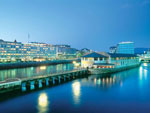Over two centuries ago, a large mansion, a dazzling architectural sample of classicism, astonishing with its harmony and outlines, was built in Tverskaya street in Moscow in the end of the 18th century. It was the splendid apartment not only outside, but also inside: expensive floors and wallpapers, refined furniture and many other things.
In the first half of the 19th century, due to efforts of the princess Volkonskaya, these magnificent premises were turned into the art temple, decorated with genuine works and copies of outstanding paintings and fresco. The literary evenings drew Russia’s most gloried poets and writers: Pushkin, Jukovsky, Tyutchev, Turgenev and others.
This elite real estate object was purchased in 1870 by a contractor Malkiel. It was then transferred from one merchant to another who totally changed it façade by giving the first floor for rent as the shops and the second floor – as luxurious apartments. However, the grand halls remained intact.
In 1898 the house was purchased by gourmet merchandiser and importer Paul Yeliseevsky. Under his command, the house was surrounded by wooden scaffolds so that no one could get inside. Such a conspiracy gives a ground for rumors that heated the interest to the house. Finally, in 1901 the mistery reveals and Moscovites are astouned by the sumptuous Yeliseev’s store and cellars for Russian and foreign wines.
One can find almost any gastronomic product here, and it would be of a highest quality. Yeliseev managed to impart Moscovits to sophisticated French products, which, nevertheless, could be competed by domestic products. There were so many brands of wine, coffee and tea that sometimes buyers had to turn to special salesmen for help.
October Revolution of 1917 put paid to Yeliseev’s future in Russia and he had to migrate to France, his shop was nationalized. The name Yeliseevsky so deeply rooted in every day life of Moscovits that it was still used even after official renaming. Apart from other large Moscow stores, Yeliseevsky retains its status of a luxury store where people came to buy scarce goods or simply enjoy the magnificent decorations.
After the revolution, part of the house was used as apartments. A famous writer Nikolay Ostrovsky who lived here in 1935-1936, wrote here his famous How the Steel was Tempered. Afterwards, this apartment turned into his memorial museum. After the disorder of USSR, the museum was renamed into State Humanitarian Museum-Center ‘Overcoming’ named after Ostrovsky. This museum is aimed at popularization of the creativity of disabled people. This direction of the museum’s activity closely intersects with the writer’s personality who used to write plays despite deceases, limited physical abilities and blindness.
This is how the luxury store and the museum of disabled persons’ creativity get on in one house. In 2003 the house underwent reconstruction as a result of which it got back its historical look. Now Yeliseevsky is rightly seen as one of the main objects of Moscow cultural heritage, embodying the refinement and luxury of the 19th century and social problems of the 20th century.







